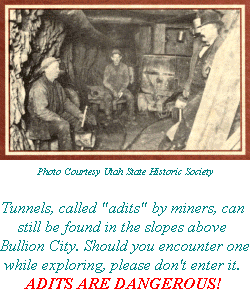 At
this stop, you can look across the bridge and upstream to the site of
what was once the center of Bullion City. During it's heyday, the
camp had dozens of buildings and over a thousand inhabitants on both
sides of the creek. The 1881 census shows the pop. of the town as
1,651 souls but 10 years later, this figure had declined to 259. At
this stop, you can look across the bridge and upstream to the site of
what was once the center of Bullion City. During it's heyday, the
camp had dozens of buildings and over a thousand inhabitants on both
sides of the creek. The 1881 census shows the pop. of the town as
1,651 souls but 10 years later, this figure had declined to 259.
Life in gold camps like Bullion City was hard. Health
conditions were poor and often there was no medicine. Lodgings
were primitive, most miners lived in tents or crude shelters with walls
of canvas, hides or rough-hewn planks. Mining for gold was hard,
monotonous labor. It was frequently necessary to work long hours
while knee-deep in mud or icy water. Mining laborers generally
worked 10 hour shifts, 6 days a week with Saturdays off.
Mining camps could also be dangerous places.
Consider this account from a nearby mining camp by Merril Utley in The
Ghosts of Gold Mountain 1992:
[Two miners by the names of R.J. Gibson and J.
Jacobs] had been imbibing rather freely of the flowering bowl and got
into a dispute over a gold claim... they mutually agreed to retire to
the street and settle their differences... As they got into the street,
they began pumping away at each other [with pistols] only a few feet
apart. (They both missed).
Fire was another danger and could easily devastate a
town made of wood and canvas. It is said that a fire storm raged
up the dirt road by the bridge on the right side of the creek (north)
destroying a number of shacks and cabins. Look across the bridge and up
the north-facing slopes of the canyon. As you drive up the road
beneath these slopes, look for islands of aspen surrounded by spruce and
fir trees. These aspen trees, recognized by their light green
leaves in summer, are what grew back after a 1923 fire that started at a
mine. |